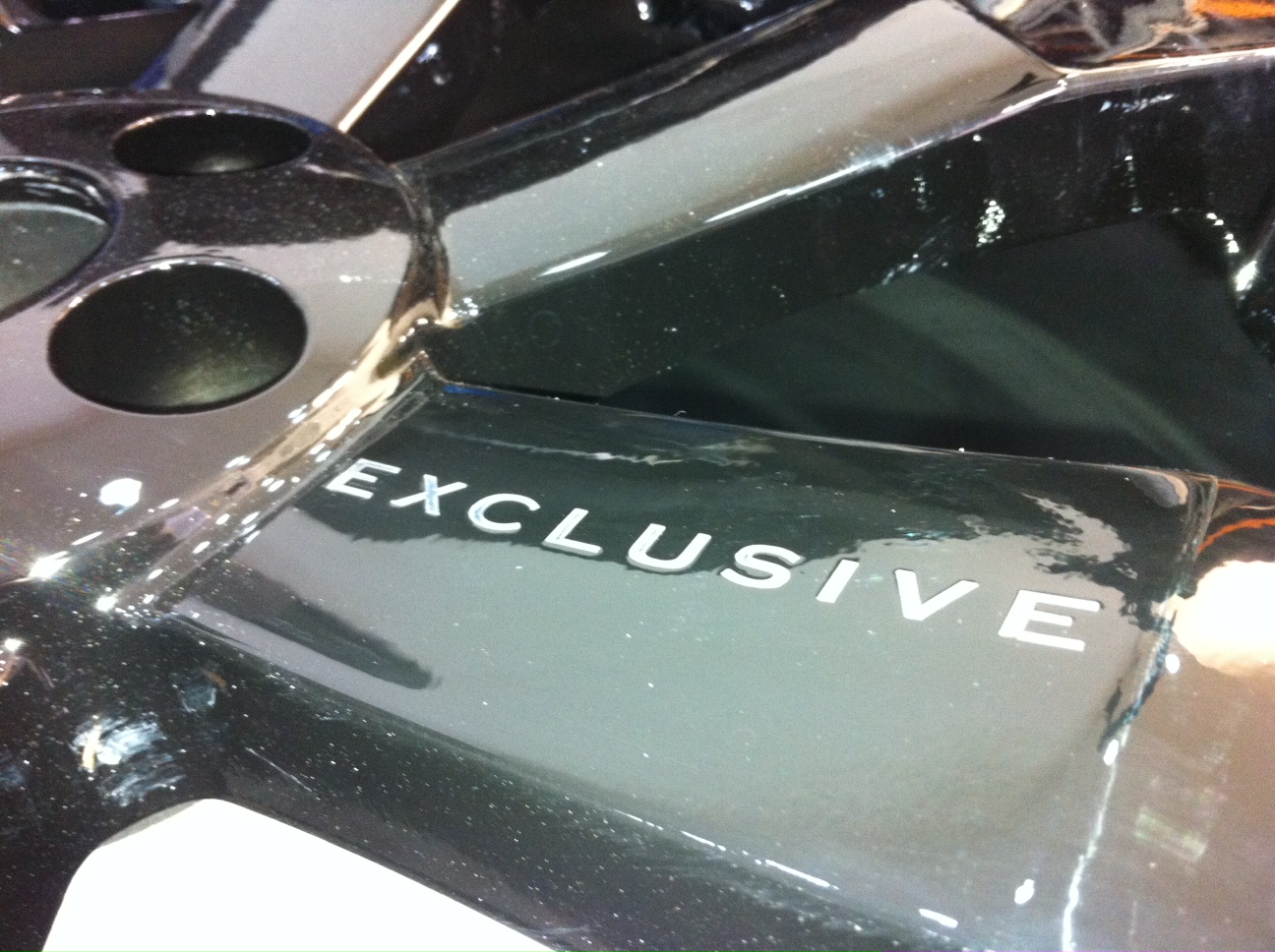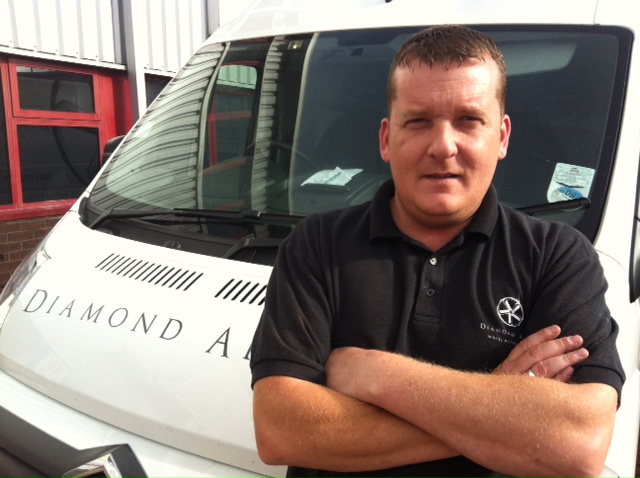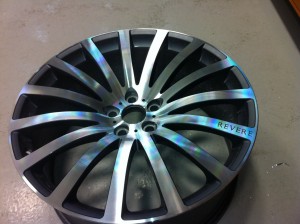 Check out these awesome Range Rover Revere 22” alloys which have just had the Diamond Alloys treatment! These alloys have been Diamond Cut, which is always easy to identify by the feint lines that appear on the surface. The finish is one of our most popular alloy wheel refurbishments and can really add the finishing touch to your car. Why buy new, when you can bring your alloys back to life with a Diamond Cut. If your alloys have seen better days, had a few scrapes and dent, then give us a call on 0845 370 2222 and we can recommend a service for you.
Check out these awesome Range Rover Revere 22” alloys which have just had the Diamond Alloys treatment! These alloys have been Diamond Cut, which is always easy to identify by the feint lines that appear on the surface. The finish is one of our most popular alloy wheel refurbishments and can really add the finishing touch to your car. Why buy new, when you can bring your alloys back to life with a Diamond Cut. If your alloys have seen better days, had a few scrapes and dent, then give us a call on 0845 370 2222 and we can recommend a service for you.
Monthly Archives: October 2012
Amazing Diamond Cut Alloy wheels
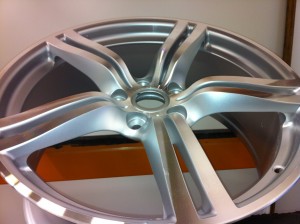 Take a look at these amazing Diamond Cut Alloy wheels that have just come off the line at our alloy wheel refurbishment centre. These came of an Aston Martin and clearly show the feint lines on the alloy; a bit like the underside of a CD, which hallmark this as a diamond cut alloy. Our Diamond cutting service is carried out on site at our alloy wheel refurbishment centre here in west London using highly skilled trained
Take a look at these amazing Diamond Cut Alloy wheels that have just come off the line at our alloy wheel refurbishment centre. These came of an Aston Martin and clearly show the feint lines on the alloy; a bit like the underside of a CD, which hallmark this as a diamond cut alloy. Our Diamond cutting service is carried out on site at our alloy wheel refurbishment centre here in west London using highly skilled trained 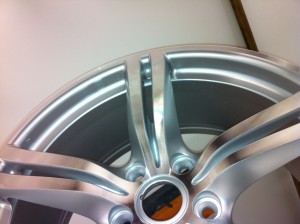 technicians, so if your alloys are looking a bit tired, give us a call and we can help bring your alloys back to life.
technicians, so if your alloys are looking a bit tired, give us a call and we can help bring your alloys back to life.
Our Latest Diamond Cut Alloy Wheels
choosing the right alloys
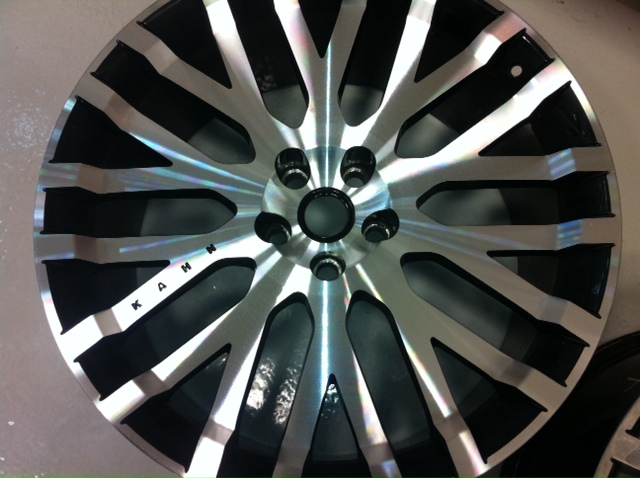 As we recently mentioned, there are a number of advantages to choosing alloy wheels. They are lightweight and this will increase the performance of your car, they look great and are much easier to customise than steel. When choosing your alloys there are a number of key points to consider.
As we recently mentioned, there are a number of advantages to choosing alloy wheels. They are lightweight and this will increase the performance of your car, they look great and are much easier to customise than steel. When choosing your alloys there are a number of key points to consider.
Getting the right style of alloy for your car is important, as their looks are definitely one of the major reasons to use alloys. There are quite a few different styles available, mostly varying the number and thickness of the spokes, so finding the right style for your car is imperative. Of course when customising your car like this, your own personal taste is the ultimate arbiter of what to choose, but there are a few generally held beliefs about the right alloys for the right car, for example low spoke count alloys generally look better on smaller cars, whilst 5-6 spokes are more suitable to a family car and the most stylish designs like a multispoke look best on sports cars.
Another thing to consider is that when changing from steel to alloy it is quite common to up-step your wheel, increasing the diameter whilst reducing the tire profile. This gives your alloys more impact, as they appear bigger and bolder. When up-stepping it is important to keep the overall diameter of the replacement wheel and tyre combination as similar as possible to the original format, so that things like the gearing remain the same as intended.
the advantages of alloy
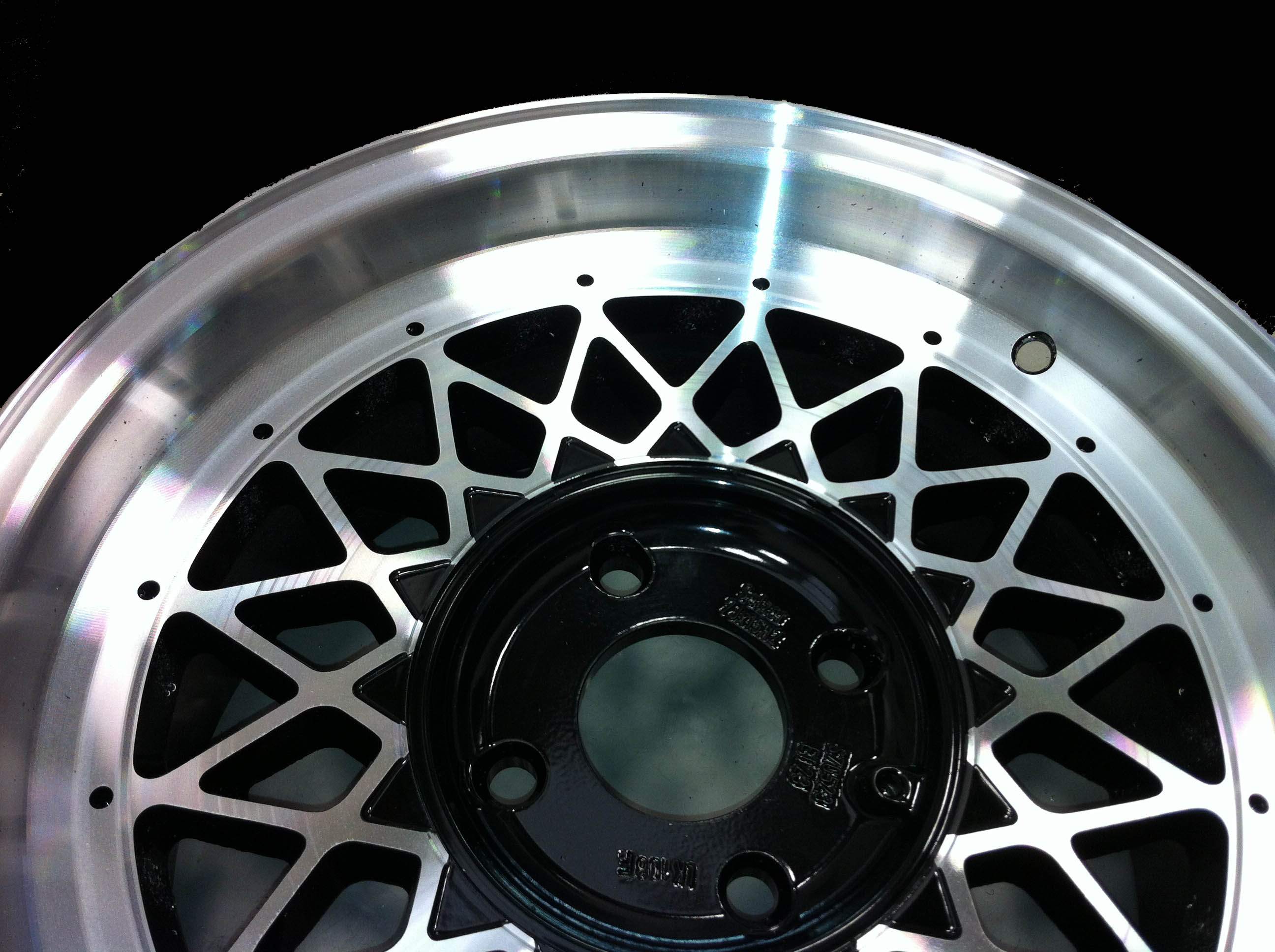 Alloy wheels have become the most common type of wheel on the road, becoming the standard on most cars now produced. The cosmetic value of alloy wheels is obvious, they simply look better than steel wheels, however there are other reasons that may not be immediately obvious as to why they have become so popular.
Alloy wheels have become the most common type of wheel on the road, becoming the standard on most cars now produced. The cosmetic value of alloy wheels is obvious, they simply look better than steel wheels, however there are other reasons that may not be immediately obvious as to why they have become so popular.
Alloys are much lighter than steel wheels and this significantly impacts on a car’s performance, alloy wheels make for better acceleration and more agile performance whilst steel wheels will lower the car’s centre of gravity and dampen acceleration. Why is this difference in weight so important when it makes up a fraction of the total weight of the car? The wheels are a dynamic part of the car subject to tremendous physical force when you accelerate and when you brake. The heavier a wheel is, the more energy is required to affect it. This has an obvious knock on effect for the performance of your car, but also means that parts of the car that interact with the energy of a wheel, like shock absorbers, will wear faster. So a low weight on the wheel is important in a lot of ways.
As well as it just looking better, there are other cosmetic benefits that alloys offer. Alloy is easier to work than steel and this opens the door to a range of customisation options for those who want their car looking that little bit extra special. Alloy wheels are also a better medium for painting on and can be finished in a variety of ways, like our Diamond cutting technique, for a better look.
So there you go, alloy wheels are the perfect choice because of their blend of practicality and beauty, making your car more responsive on the road and looking better whilst doing it.
make do and mend – why buy new alloys when you can refurbish?
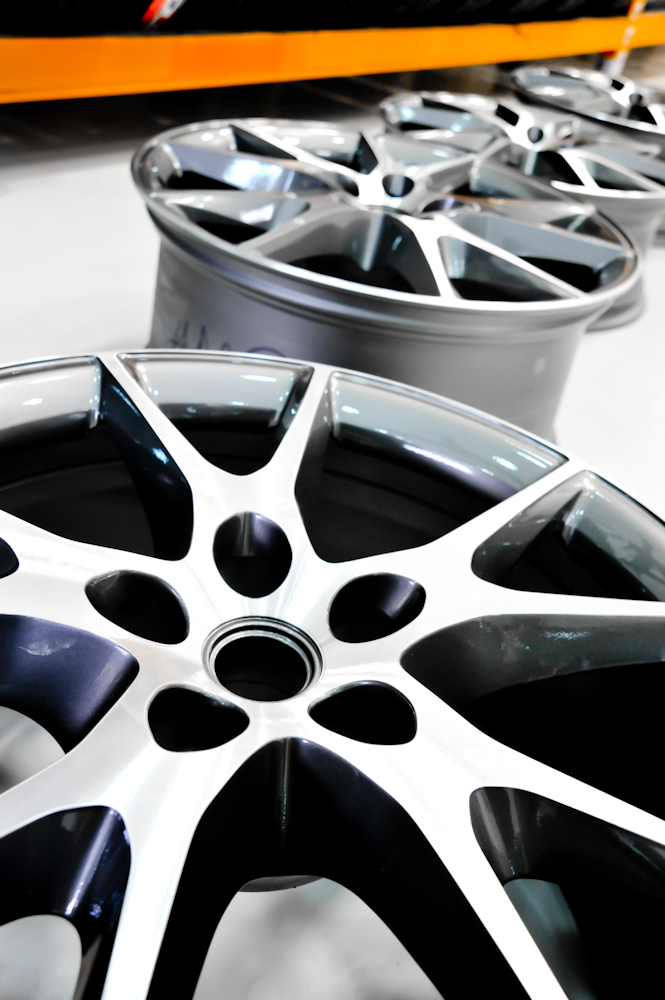 Alloy wheels look great, but every day wear and tear will cause them to degrade, and it’s easy to get them scuffed or chipped on a pavement. This can seem quite daunting, as a new set of alloys, to replace a worn out pair, can cost hundreds of pounds. However, there is a much more cost effective, quicker and less wasteful solution available to solve the problem. Getting alloys refurbished with Diamond Alloys can cost as little as £65 for a standard refurbishment and will return them to a great condition and help protect them against future damage.
Alloy wheels look great, but every day wear and tear will cause them to degrade, and it’s easy to get them scuffed or chipped on a pavement. This can seem quite daunting, as a new set of alloys, to replace a worn out pair, can cost hundreds of pounds. However, there is a much more cost effective, quicker and less wasteful solution available to solve the problem. Getting alloys refurbished with Diamond Alloys can cost as little as £65 for a standard refurbishment and will return them to a great condition and help protect them against future damage.
Another reason to consider refurbishing alloys is that they open up the possibility of enhancing your cars appearance beyond even the showroom standard, with diamond cutting and customisation options available at prices well under the cost of a new set of alloys you can make your wheels look better than new. See our post about hydro graphic printing for just one of the options that Diamond Alloys offers.
To make sure your alloys keep looking their best for longest, be sure to read our advice on caring for your alloy wheels after a refurbishment too.
keeping your newly refurbished alloys looking as good as new
Alongside everyday grit, brake dust is probably the single biggest factor is tarnishing your alloys. This is because brake dust can be corrosive to the paint and lacquer protecting your alloys, but it is also produced regularly as a result of the friction between brake discs and pads. Whilst it sounds harmless, brake dust is made up of metal filings, carbon fibres and acidic adhesive residues and can hit the alloys at very high temperatures.
Because of this, corrosion to your alloys is inevitable and they will need to be refurbished, however there are inexpensive ways you can prolong the life of your alloys and therefore reduce how often they need to be refurbished.
Regular washing is key to reducing the effects of brake dust and maintaining your alloys. We recommend that you try to wash your wheels once a week, this may seem like a lot but once etching sets in you’ll be fighting a losing battle, so it’s best to keep on top of washing off the brake dust and grit. Avoid using dedicated alloy wheel cleaners and abrasive cleansers like wire wool, these can very well cause as much harm as good in the long run, car-wash wheel cleaners can also strip the lacquer and paint away through their jet washing. The best method for cleaning your wheels is really the most simple, hose the wheels down to remove the loose abrasive grit and then wash down with warm, mildly soapy water using a non-abrasive cloth or sponge.
Less frequent waxing also helps to protect the paint and lacquer, prolonging the life of your alloys. Here, it is more useful to use dedicated alloy wax, though remember to apply it non-abrasively!
Those are two very easy, cheap and effective ways of maintaining the quality and life of your alloy wheels.
Meet Jay, the Driver
“I love being out on the road, meeting the clients in and around London. The best part is seeing the happy surprise when we deliver so promptly without compromising on the quality workmanship.”
Jay’s position on the Diamond Alloys team is no happy accident, from day one Director Phil Murdoch was determined to have Jay on board as the driver for the Diamond Alloys van, “I have known Jay for a while and knew he was the man for the job, so kept on insisting he join our team and new business venture.”
At his new position in Diamond Alloys, Jay has been put to good use as an asset to the company in all areas of its business, with training in the use of the Diamond cutting machine and in stripping the alloys from the tyres and re-fitting tyres and wheels to the car, Jay is able to pitch in on the refurbishment. But mainly, Jay is here because he’s the best man for the job driving the van and delivering the proud results of another day at Diamond Alloys.
In Jay’s interview, we asked him all about cars!
If you could have any car, what would it be?
It wouldn’t hesitate is choosing a Range Rover Sport because it has levels of comfort that I think cannot be matched and it would also allow and plenty of room for the kids.
What would you do to the alloys?
I would definitely choose a diamond cut for the alloys because I think it’s the best finish you can get and they stand out, especially with black inserts on a black range rover.
If you could drive anywhere in your chosen car, where would you go?
If I could drive anywhere it would definitely be to Monaco so I could experience a drive around the Grand Prix circuit!
When out in the Diamond Alloys van, what do you listen to?
I tend to listen to Magic on the radio and I have to admit the rest of the way it would 80s music!
What was your first car?
My first car was a Ford Fiesta, a far cry from my dream Range Rover, but it was all I could afford when it came to the insurance!
Cracked 19” BMW Alloys
BMW owners among you have probably been watching a story broken by BBCs Watchdog regarding an unusually large incidence of cracking in their 19” alloys installed in run-flat tyres.
If you are worried about this, or have experienced it, we highly recommend reading the Watchdog article and its update on BMW offering to pay for replacement of some cracked alloys.
Remember that with all alloy cracking of all types, you should always replace and not repair. Diamond Alloys does not repair cracked wheels because if a weld breaks it could result in fatalities. Even if the wheel gets welded to repair the crack, this can sometimes break if it is not strong enough and we consider this an unacceptable risk to our clients.
hydrographics carbon fibre effect for wheels
Here at Diamond Alloys we’ve got a new option for those of you wanting a bit of extra personalisation on your alloys, hydrographic printing.
Hydrographic printing is a great method for applying complex, personal designs onto three dimensional objects – like a wheel. The process involves imprinting a design onto a PVA film which is then floated on the surface of a body of water. The film then gets sprayed with an activator chemical which dissolves it on top of the liquid and activates a bonding agent. Finally, the alloys are dipped into the water, and the floating ink layer wraps around and sticks to it, leaving an instant perfect finish without air bubbles, wrinkles or blemishes.
We’re really excited to add this to the services we offer that also include powder coating and painting, as well as our diamond cutting.
Call us on 0845 370 8881 or contact us direct for your persoanl hydrographics quote!




 Follow
Follow